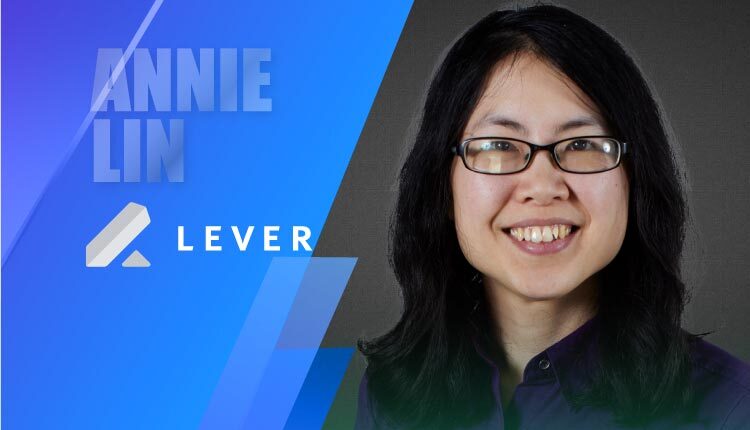Journey into Tech
1. Hi, please tell us about your role and the team/technology you handle at Lever? How did you arrive here?
I lead the People function at Lever, which encompasses recruiting, HR, L&D, D&I, workplace, internal communications, and culture. I have deep leadership experience across business ops/management and people/talent, helping to successfully grow companies including Uber, General Assembly, and HotelTonight. I believe deeply in the symbiotic relationship between caring for the business and caring for people, and am driven by cultivating industry-leading work environments — a mission I’m excited to work on every day with Lever’s people-focused team and customers.
2. How have HR Tech management practices evolved in the last 2-3 years?
In Josh Bersin’s latest report, he notes that there’s a large disruption in the HR tech market as HR technology makes the move to “work tech”. It’s no surprise that the pandemic has reinvented the way people work and the technology needs that come with it. The entire market is making a shift to systems of design to enable employees to personalize their experiences and for their various roles. Everyone is working towards integrations with productivity apps like Microsoft Teams, Slack, Zoom, and the like, and trying to have as few interfaces as possible to collaborate with peers and use benefits.
A lot of companies are trying to find tools that help them provide the most personalized experience possible to address each employee’s needs, which is no easy feat.
Read More: HR Tech Interview with James Scott, CEO and Co-Founder at Thrive
3. Did COVID-19 lockdown change the way HR policies are now understood by the CHROs and CPOs?
I think the pandemic changed the way everyone views HR policies. HR-related policies, processes, and programs have become (or have needed to become) closer than ever before to how the business runs day in day out. It has always been a myth that people can fully separate their work and home lives.
Then, suddenly with COVID-19 and remote working, everyone comes to see just how impossible that myth is and how “personal” challenges (which there have been many, many of this past year) deeply affect people’s work selves, and how important it is to help teams feel supported, included, and empowered in both their professional lives and beyond.
4. How is employee engagement related to the culture of an organization?
Employee engagement is a direct outcome of the culture of an organization.
Culture, to me, is about what we value, and how we put those values into action every day, creating the environment and experience that employees encounter (and contribute to). And that environment and experience directly influence whether people feel like they can be themselves at work, they can do their best work, they feel a sense of purpose and meaning at work, they are growing through their work — all of which drive their engagement, retention, and performance.
5. Could you tell us more about recent hiring trends in the industry and how Lever is enabling users to meet their hiring goals?
Many companies – large and small – last year went through hiring freezes or layoffs, and unemployment was at an all-time high. As more companies have adapted to working from home and reprioritizing their needs, hiring has picked back up again, and unemployment rates are starting to drop.
Lever enables users to meet their hiring goals through our complete Talent Acquisition Suite, LeverTRM. LeverTRM is the only solution combining an applicant tracking system (ATS) and robust customer relationship management (CRM) capabilities all in one product — providing the complete talent acquisition solution for organizations of any size.
Using Lever, recruiting teams are able to customize their approach to nurturing candidates and building a strong relationship with them from the start, provide advanced analytics on talent data for impactful insights through dashboards, and reduces biases when making hiring decisions.
Read More: HR Tech Interview with Anna Sannö, Research Strategy Manager at Volvo Construction Equipment
6. Tell us more about the relationship between DEI and Digital Transformation?
Technology plays a large role in measuring the success of DEI. Through using technology, teams are informed about where they should focus and how they should measure progress.
For companies that are just getting into DEI, the first thing I would say to do is to take a look at your data. If you don’t have good data, your first step should be how to get high-quality and comprehensive data on the state of DEI at your company, and you can determine whatever state or stages you want to focus on. Then you can set explicit targets to get better, and how to get to that target.
For example, one of the ways we use tech is to leveraging our own product to cultivate DEI at Lever. The Lever software has a flexible Diversity Insights Survey within it, that the team uses to get (anonymous, optional) demographic insights on our candidates. This has allowed us to identify where we’re doing well and where there are gaps in our DEI efforts, informed the DEI goals we’ve set, and continued to help us track and measure progress.
7. How to effectively discuss DEI with candidates during the interview process and what they expect from the companies that hire them?
We just conducted a survey of ~1,500 (employers, employees, and candidates) that shared that 42% of candidates are inquiring about how their prospective employers are tackling DEI. More and more candidates are looking for DEI pages on company’s websites for their commitments to progress. Candidates are expecting companies to have a more serious commitment to DEI than ever before.
The most effective practice in discussing DEI with candidates during the interview process is highlighting DEI throughout every part of the candidate experience. We try to communicate what we’re doing and our commitment to the process, without people even having to ask. For example, one of our email templates to candidates from the very beginning asks them to share their preferred pronouns with us to make sure we address them correctly if they choose to share. This goes out at one of the very first touchpoints.
Additionally, as candidates are going through the interview process, we share an optional diversity survey to gather insights that help us continue to improve on our hiring processes, showing our commitment to DEI with candidates, without them necessarily having to ask.
8. Where to start: Three DEI practices that any business can implement immediately:
The only way for DE&I to become infused into the everyday fabric of the organization is if every program, process, policy, and decision you make pays attention to being inclusive. Our strategy to ensure diversity is 3 simple steps:
- Think of DE&I as a key criterion for every decision you make,
- Pay just as much attention to the small daily moments
- Be equally intentional about what you aren’t inclusive toward.
Read More: HR Tech Interview with Dr. Andrew Temte, President and Global Head of Corporate Learning at Kaplan
9. What are the time-tested ways to cultivate a workplace culture that actually inspires DEI?
The best way to cultivate a workplace culture that actually inspires DEI is one that is constantly evolving to be better, admittedly. On our team, and for every stage of the employee lifecycle, we call each other out and ask, “How can we make this more inclusive,” to continue to hold each other to a higher standard.
Another way we’ve inspired DEI work across the company is by investing time and money into our Employee Resource Groups (ERGs). ERGs allow employees with a particular commonality (ethnicity, gender, parent status, etc.) to share a space and support each other and spread awareness. An ERG can go a long way in helping employees feel accepted and included in their company culture.
Thank you, Annie! That was fun and hope to see you back on HR Tech Series soon.
[To participate in our interview series, please write to us at sghosh@martechseries.com]
Annie Lin is the VP, People at Lever, the modern recruiting software that tackles the most strategic challenge that companies face: how to grow their teams. Annie‘s team spans recruiting, HR, L&D, D&I, workplace, internal comms, and culture. She brings a decade of leadership experience across business ops/management and people/talent, helping to successfully grow companies including Uber, General Assembly, and HotelTonight. She believes deeply in the symbiotic relationship between caring for the business and caring for people, and is driven by cultivating industry-leading work environments. She’s excited to work on this mission everyday with Lever’s people-focused team and customers.
 Lever is a leading Talent Acquisition Suite that makes it easy for talent teams to reach their hiring goals and to connect companies with top talent. Lever is the only platform that provides all talent acquisition leaders with complete ATS and robust CRM capabilities in one product, LeverTRM. The Lever Hire and Lever Nurture features allow leaders to scale and grow their people pipeline, build authentic and long-lasting relationships, and source the right people to hire. Lever Analytics provides customized reports with data visualization, see offers completed and interview feedback, and more, to inform strategic decisions between hiring managers and executives alike.
Lever is a leading Talent Acquisition Suite that makes it easy for talent teams to reach their hiring goals and to connect companies with top talent. Lever is the only platform that provides all talent acquisition leaders with complete ATS and robust CRM capabilities in one product, LeverTRM. The Lever Hire and Lever Nurture features allow leaders to scale and grow their people pipeline, build authentic and long-lasting relationships, and source the right people to hire. Lever Analytics provides customized reports with data visualization, see offers completed and interview feedback, and more, to inform strategic decisions between hiring managers and executives alike.


